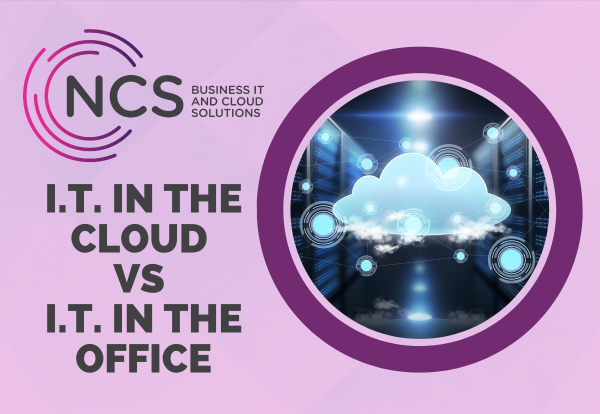I.T. in the Cloud vs I.T. in the Office
I.T. in the Cloud vs I.T. in the Office
Which is the better choice?
In the ever-evolving landscape of IT, trends often come full circle. One such phenomenon is the resurgence of on-premise workloads. Despite the rise of cloud computing and the allure of offloading infrastructure to third-party providers, organisations are now recognising there are some advantages of bringing workloads back in-house.
Cloud computing has, undoubtedly, revolutionised how businesses consume and deliver IT services. The cloud’s scalability, agility, and cost-effectiveness drove a massive shift in workloads from on-premise servers to remote data centres. The ability to quickly provision resources, reduce upfront capital expenditure, and enjoy the benefits of elasticity and pay-as-you-go pricing became the holy grail of IT.
However, as organisations increased their cloud presence, certain challenges began to surface. Concerns over data privacy, security, compliance, and governance grew louder. Additionally, unexpected costs associated with data and bandwidth usage started to impact budget planning. These factors, coupled with the need for greater control and flexibility, have led organisations to re-evaluate their cloud strategies.
Some of the reasons organisations have taken IT back on-premise include:
- Data Governance and Compliance: Industries such as healthcare, finance, and government face stringent regulations regarding data handling. Storing sensitive data on-premise allows organisations to maintain compliance, retain full control over data access, and mitigate the risk of regulatory violations.
- Performance and Latency: Certain workloads, such as real-time analytics, high-frequency trading, and latency-sensitive applications, require the fastest network speeds and minimal network latency. By running these workloads on-premise, businesses can reduce the distance data travels, ensuring faster response times and better overall performance.
- Cost Optimisation: While cloud services offer flexibility, they can become cost-prohibitive as workloads scale-up. Organisations that have predictable or stable workloads often find it more cost-effective to maintain their own infrastructure, eliminating the ongoing operational expenses associated with the cloud.
- Data Sovereignty: In some cases, businesses or governments have legal or policy requirements that mandate data to reside within specific geographic regions. On-premise infrastructure ensures compliance with data sovereignty regulations and avoids potential conflicts arising from cross-border data transfers.
- Hybrid Cloud Strategies: Rather than adopting an all-or-nothing approach, many organisations are embracing hybrid cloud models. By strategically placing workloads on-premise and leveraging cloud services where appropriate, businesses achieve a balance that optimises control, scalability, and cost-effectiveness.
While cloud computing has been transformative, organisations are realising there is value to on-premise IT by retaining control, security, and flexibility over their critical applications and infrastructure.
It is essential for businesses to evaluate their specific requirements and strike a balance between the advantages offered by cloud computing and the benefits of on-premise infrastructure.
Whether it’s the need for data control, compliance, or optimised performance, organisations must choose a strategy that aligns with their long-term goals. By embracing the circular nature of IT, we can continue to adapt and evolve, leveraging the best of both worlds to meet the unique demands of our digital age.
Posted in News


